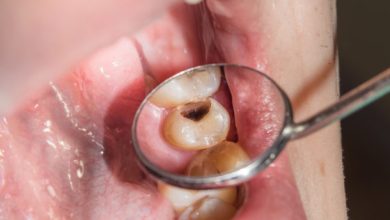What Happens With Tooth Decay: The Silent Threat to Your Smile

Tooth decay occurs when bacteria in the mouth produce acids that attack the tooth’s enamel, leading to the formation of small holes called cavities. If left untreated, tooth decay can cause pain, infection, and even tooth loss.
It is important to address tooth decay promptly to prevent further damage and maintain oral health.

Credit: www.periodontistwilmington.com
The Tooth Decay Process: How Bacteria Attack Your Teeth
Tooth decay begins when bacteria in your mouth make acids that attack the tooth’s surface (enamel). This can lead to a small hole in a tooth, called a cavity. If tooth decay is not treated, it can cause pain, infection, and even tooth loss.
Tooth decay is the result of an infection with certain types of bacteria that use sugars in food to make acids. Over time, these acids can create a cavity in the tooth.
The acids produced by bacteria in the mouth attack the enamel, which is the protective outer layer of the tooth. This can weaken and damage the enamel, making it more susceptible to decay.
If the tooth decay process continues, more minerals are lost and the enamel is weakened and destroyed, forming a cavity. A cavity is permanent damage that a dentist has to repair with a filling.
The Consequences Of Untreated Tooth Decay
Untreated tooth decay can lead to pain, infection, and even tooth loss. Bacteria in the mouth produce acids that attack the tooth’s enamel, causing cavities. It’s important to seek treatment to prevent further damage and maintain oral health.
| The Consequences of Untreated Tooth Decay |
|
Prevention And Treatment Strategies For Tooth Decay
Tooth decay occurs when bacteria in the mouth produce acids that attack the enamel, leading to the formation of cavities. If left untreated, tooth decay can cause pain, infection, and even tooth loss. Preventive measures such as regular dental check-ups, brushing and flossing, and a balanced diet can help prevent and treat tooth decay.
- Brush your teeth at least twice a day using a fluoride toothpaste, focusing on all tooth surfaces and along the gumline.
- Floss daily to remove plaque and food particles from between your teeth and under the gumline.
- Rinse your mouth with an antimicrobial mouthwash to kill bacteria that cause tooth decay.
- Avoid sugary snacks and drinks, especially those high in refined sugars.
- Limit your consumption of sugary foods and drinks to mealtimes to minimize the exposure of your teeth to sugar.
- Choose healthier snacks like fruits, vegetables, and dairy products.
- Visit your dentist at least twice a year for professional cleanings and dental examinations.
- Your dentist will be able to detect early signs of tooth decay and provide appropriate treatment.
- Your dentist may recommend fluoride treatments to strengthen your tooth enamel and reduce the risk of cavities.
- Sealants can be applied to the chewing surfaces of your back teeth to provide an extra layer of protection against decay.
- If a cavity is detected, your dentist will remove the decayed portion of the tooth and fill it with a dental filling.
- In more severe cases, a dental crown or root canal treatment may be necessary.
Frequently Asked Questions For What Happens With Tooth Decay
What Happens If Tooth Decay Is Left Untreated?
If tooth decay is left untreated, it can lead to pain, infection, and even tooth loss. Bacteria in the mouth create acids that attack the tooth’s surface, causing small holes called cavities. These cavities can worsen over time, causing more damage and potentially leading to more serious dental problems.
It is important to seek treatment for tooth decay to prevent further complications.
Can Tooth Decay Be Fixed?
Tooth decay can be fixed by a dentist. If left untreated, it can cause pain, infection, and tooth loss. Dentists can repair tooth decay by filling the cavity with dental materials. It’s important to treat tooth decay early to prevent further damage.
Is It Okay To Leave A Decayed Tooth?
Leaving a decayed tooth untreated can lead to pain, infection, and potential tooth loss. Cavities are caused by tooth decay, a progressive disease that worsens over time. The longer a cavity is left untreated, the deeper it can penetrate the tooth, causing more extensive damage.
It is important to seek dental treatment as soon as possible to prevent further complications.
How Long Can You Go With Tooth Decay?
Tooth decay can lead to cavities, pain, infection, and tooth loss if not treated. The timeline for treatment varies, ranging from six months to four or five years depending on individual factors like tooth enamel strength. It’s crucial not to delay getting treatment for tooth decay.
Conclusion
Tooth decay is a serious oral health issue that should not be overlooked. If left untreated, it can lead to pain, infection, and even tooth loss. The bacteria in your mouth produce acids that attack the tooth’s surface, causing small holes called cavities.
These cavities can worsen over time if not addressed by a dentist. It’s important to prevent tooth decay by practicing good oral hygiene and seeking regular dental check-ups. Don’t let tooth decay compromise your oral health – take action and protect your smile.




